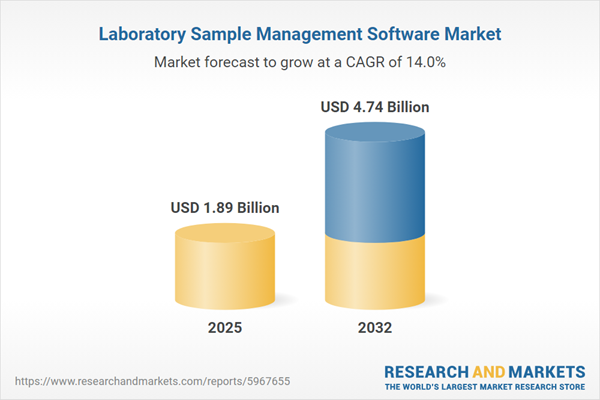Speak directly to the analyst to clarify any post sales queries you may have.
The laboratory sample management software market is evolving rapidly as advanced technology, complex compliance requirements, and global trade factors intersect. Senior executives across regulated industries recognize the necessity of robust digital tools to streamline laboratory workflows, safeguard data integrity, and stay ahead in an increasingly competitive landscape.
Market Snapshot: Laboratory Sample Management Software Market
The laboratory sample management software market grew from USD 1.65 billion in 2024 to USD 1.89 billion in 2025. It is expected to sustain a CAGR of 14.04%, with projections reaching USD 4.74 billion by 2032. This expansion is powered by pharmaceutical innovation, life sciences digitization, stricter regulatory environments, and the widespread transition from manual processes to automated, analytics-driven platforms. The Americas, Europe & Middle East & Africa, and Asia-Pacific are experiencing surges in adoption, each with unique regulatory and infrastructure influences shaping procurement priorities.
Scope & Segmentation
- Application Areas: Data integration for analytics, ERP, and LIMS; inventory management; sample tracking; workflow automation (alerting, process scheduling, task management).
- Deployment Models: Cloud, hybrid, and on-premises installations offer varying degrees of scalability, accessibility, and compliance suitability.
- End Users: Academic institutions, biotechnology enterprises, environmental testing firms, food and beverage industry, pharmaceutical manufacturers.
- Sample Types: Biological (blood, cell culture, DNA, tissue); chemical (gases, liquids, solids); environmental (air, soil, water).
- Organization Size: Large enterprise, medium enterprise, small enterprise.
- Geographies Covered: Americas (United States, Canada, Mexico, Latin America), Europe (United Kingdom, Germany, France, Russia, Italy, Spain, Netherlands, Sweden, Poland, Switzerland), Middle East (United Arab Emirates, Saudi Arabia, Qatar, Turkey, Israel), Africa (South Africa, Nigeria, Egypt, Kenya), Asia-Pacific (China, India, Japan, Australia, South Korea, Indonesia, Thailand, Malaysia, Singapore, Taiwan).
- Competitive Landscape: Reports include companies such as Thermo Fisher Scientific Inc., LabWare, Inc., Abbott Laboratories, LabVantage Solutions, Inc., Dassault Systèmes SE, Agilent Technologies, Inc., PerkinElmer, Inc., Autoscribe Informatics Ltd., Accelerated Technology Laboratories, Inc., Core Informatics, LLC.
Key Takeaways for Senior Decision-Makers
- Automation and advanced analytics integration are becoming indispensable as laboratories seek to enhance operational efficiency and decision speed in complex environments.
- Cloud and hybrid deployments are gaining traction, but on-premises solutions remain essential for sensitive data or stringent regulatory requirements.
- Interoperability across ERP, analytics, and LIMS systems is now a baseline demand, facilitating collaboration, rapid deployment, and reduced integration overhead.
- Sector-specific needs shape platform requirements, such as compliance-ready solutions for pharmaceuticals and traceability features in food and beverage sectors.
- Vendor partnerships, ecosystem interoperability, and modular architectures are key strategies for providers to sharpen competitive differentiation and accelerate time-to-value for clients.
Anticipating Tariff Impact
Newly imposed US tariffs scheduled for 2025 are expected to influence equipment and consumables costs, introducing additional budgeting complexity for laboratories. Higher duties on sample management instruments and imported reagents may prompt organizations to adjust procurement cycles, renegotiate supplier contracts, and reevaluate leasing versus buying strategies. Software vendors could also revisit licensing or subscription models to safeguard profitability amid rising development and validation costs.
Methodology & Data Sources
Findings are underpinned by a rigorous mixed-methods approach, integrating in-depth primary interviews with laboratory decision-makers and comprehensive secondary research from industry publications, regulatory documents, and technology analyses. Quantitative and qualitative techniques ensure that trends and drivers are accurate, consistent, and actionable for business leaders.
Why This Report Matters
- Provides a detailed view of competitive strategies, technological innovations, and upcoming challenges impacting laboratory operations worldwide.
- Breaks down market segments and deployment preferences critical for effective product selection and strategic planning.
- Equips leadership teams with actionable intelligence to future-proof investments and optimize laboratory sample management outcomes amid shifting trade and regulatory landscapes.
Conclusion
This report equips stakeholders with the clarity and foresight needed to navigate laboratory sample management system transitions with confidence. Strategic planning informed by this analysis will help organizations secure operational continuity, compliance, and long-term growth.
Additional Product Information:
- Purchase of this report includes 1 year online access with quarterly updates.
- This report can be updated on request. Please contact our Customer Experience team using the Ask a Question widget on our website.
Table of Contents
3. Executive Summary
4. Market Overview
7. Cumulative Impact of Artificial Intelligence 2025
Companies Mentioned
The companies profiled in this Laboratory Sample Management Software market report include:- Thermo Fisher Scientific Inc.
- LabWare, Inc.
- Abbott Laboratories
- LabVantage Solutions, Inc.
- Dassault Systèmes SE
- Agilent Technologies, Inc.
- PerkinElmer, Inc.
- Autoscribe Informatics Ltd.
- Accelerated Technology Laboratories, Inc.
- Core Informatics, LLC
Table Information
| Report Attribute | Details |
|---|---|
| No. of Pages | 184 |
| Published | October 2025 |
| Forecast Period | 2025 - 2032 |
| Estimated Market Value ( USD | $ 1.89 Billion |
| Forecasted Market Value ( USD | $ 4.74 Billion |
| Compound Annual Growth Rate | 14.0% |
| Regions Covered | Global |
| No. of Companies Mentioned | 11 |









